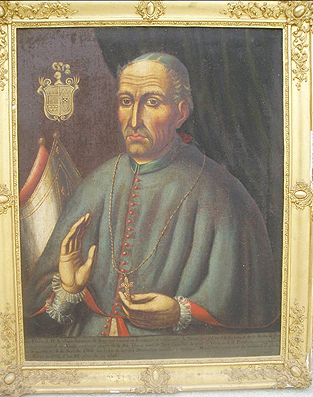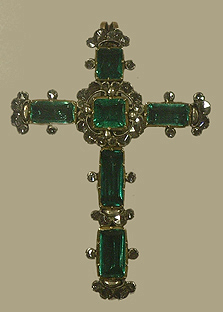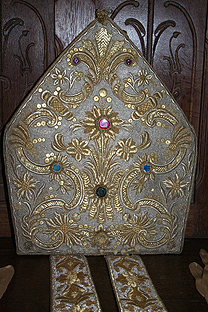The piece of the month of November 2006
EPISCOPAL INSIGNIA OF DON JUAN LORENZO DE IRIGOYEN Y DUTARI
Naiara Ardanaz Iñarga
Chair of Navarrese Heritage and Art
Christian culture and liturgy have been filled with a deep symbolic meaning. One sample of them are the insignia that distinguish a bishop from other presbyters and faithful. The bishop was the highest ecclesiastical governor of the diocese over which he presided and had as his task the spiritual welfare of all believers, both clergy and laity, and the governance of all secular and some regular ecclesiastical institutions. His Chair, symbol of his official document to teach and of his pastoral power, is at the same time the element that turns a church into a cathedral. All this has been symbolically manifested since ancient times, especially in the centuries of the Ancien Régime and today.
There are some insignia such as the mitre, the crosier, the ring, the pectoral cross as well as accessories of the liturgical vestments such as the gloves and the caligas that are reserved to the persons who received the episcopal order.
At the death of the bishop his goods remained for the cathedral over which he presided except for the piece that was claimed by the nunciature.

Portrait of Don Juan Lorenzo de Irigoyen y Dutari
In the present case we have some of the insignia of Bishop Irigoyen y Dutari who governed the diocese of Pamplona between 1768 and 1778, after having been for twenty years Prior of Velate, one of the dignities of the Cathedral. The life of this prelate was marked by great austerity and poverty staff, but he did not fail to give great importance to the protocol and ceremonial proper to his dignity. Although it is true that he distanced himself from other prelates who preceded him in the ordering of jewels and ornaments, since the few insignia that we know of, thanks both to the inventory of goods made before his consecration as bishop and to that of his last will and testament, show that he hardly ordered anything of this kind subject. Likewise, the personality of the prelate together with the custom of the Chapter of the Cathedral of Pamplona of giving some jewels to its canons and dignitaries when they were elected to be bishops, leads us to think that some of them come from the sacristy of the Cathedral itself.

Pectoral cross of Bishop Irigoyen. Treasury of the Cathedral of Pamplona.
Of these, the ones that were given to his family after his death have survived to the present day, including a pectoral with a matching ring. It is a Latin cross with diamonds set in yellow gold. The arms are formed by emeralds with rectangular table cut and in the terminations geometrical ces settings with four rose-cut diamonds arranged in a fan. The motif is repeated on the lower arm. The square is formed by a central square table-cut emerald and also repeats the model of the endings with geometrical "C" settings and diamonds arranged in the shape of a fan.

Bishop Irigoyen's ring. Treasure of the Cathedral of Pamplona.
The ring that matches the pectoral, also in emerald and diamonds, repeats the design except that the central chaton is arranged in a rhomboid shape with the four Cs at the vertices of the square emerald, with their corresponding diamonds, suggesting the shape of a cross. In Spain the pastoral ring, symbol of the mystical betrothal between the bishop and his church, was part of the insignia of the pontiff as early as the 7th century. They were usually made of gold and adorned with precious stones. The prelate had the privilege of wearing it even during the celebration of Mass.

Bishop Irigoyen's miter. Parish of Errazu
The following insignia is a mitre inlaid in gold on a silver field with fourteen non-fine stones of different colors. That is to say, embroidered in gold thread, a technique that was very important in the 18th century. From the characteristics it seems that it could come from the workshop of Zaragoza. In the inventory of goods before the consecration it is present and it is recorded how it was examined by the silversmith Jose de Jiraud because of its rarity and as it was seen that the colored stones were of little value they were not appraised. The mitre was valued at 500 reales. In spite of this, the bishop would use this miter in the most important feasts, when in the official document the Te Deum was sung and in the mass the Gloria in Excelsis Deo, as well as in the blessings and solemn processions, because he did not have another more valuable than this one.

Bishop Irigoyen's gloves. Parish of Errazu
Likewise, two pairs of silk gloves, white with gold embroidery, also considered very special, have been preserved and were valued at 320 reales. The gloves or chirotecae, entered the liturgical service as an exclusive accessory of the bishops in the X century. They were generally white, made of silk and adorned on the upper part with a circular golden plate, on which a cross or monogram of Christ was designed. The symbolism of the gloves, contained in the prayer that the consecrating bishop recites when imposing them on the neoconsecrated, explains the reason for their introduction, to keep the hands clean. It is about the glove the way in which the pontifical ring was worn.
Curiously, we have more data about some of these jewels, which show us the value they had for his family, for whom the bishop had died in the odor of sanctity. Twelve years after the death of the bishop his nephew, Miguel Fernando, the one who remained for the house, crossed the border of the Kingdom before the fear of the French invasion and in Logroño, on November 6, 1794, he had to declare the things that he carried, among them the mitre, ring and pectoral seen, that were said that they had been of Illmo Sr. D. Juan Lorenzo de Irigoyen bishop of Pamplona. The nephew returned to Errazu with all that he had taken on May 14, 1796.
Likewise, some of them are mentioned again by his nephew Miguel José, bishop of Zamora and later of Calahorra, in his will made in 1848, before his consecration: "To my sister Dº Joaquina Teresa Irigoyen... will be returned the two pectorals and a Mitre that belong to her house and belonged to my uncle, the Illmo Sr. D. Juan Lorenzo de Irigoyen, bishop of this diocese (...)" Pamplona March seventeenth and seventeenth, eighteen hundred and forty-eight.
